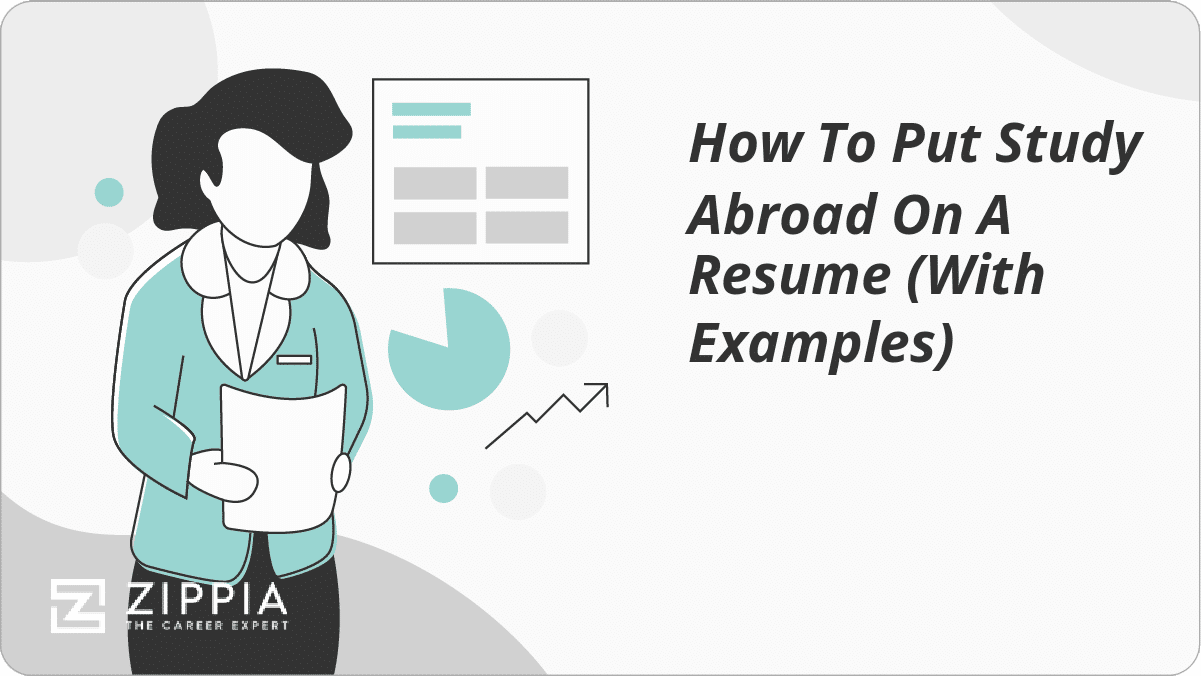How To Put Study Abroad On A Resume (With Examples)

Study abroad generally has a few overarching experiences which require a set of skills many hiring managers and recruiters are looking for in an ideal employee.
Let’s take a look at some things you’ve probably encountered while studying abroad:
- Try things outside your comfort zone
- Find resources to help you complete more simple tasks
- Communicate through language barriers
- Learn to be more independent
- Learn more self-accountability
Consider the above statements for a few minutes — how have you experienced them in your own time abroad? If you did, think about what skills you needed to overcome these challenges or try these new things.
Here are some skills we had in mind:
- Cross-cultural communication
- Working in diverse teams
- Working independently
- Resourcefulness
- Dependability
- Flexibility
- Cultural sensitivity
- Second language
Keep in mind that there are many other skills that you might have developed from your time abroad, especially if you had an internship or took classes that weren’t taught in English.
Write down your key experiences and then associated skills on paper. Once you have your skills detailed out, you can start plugging them into your resume.
Where to Put Study Abroad on a Resume
Depending on how long and what you did while studying abroad, study abroad can go to three different places in a resume.
- Education section. If you studied abroad for a short period or mostly kept to classes and seminars, you can include the study abroad in your education section. If you studied abroad for a long time and need to explain a gap in credits from your home institution, you can also add it to your education section. If you’d rather just keep the study abroad section to the education section of your resume and add your skills associated with your study abroad to your skills section of your resume, that’s okay as well.
- Volunteer section. If you studied abroad and the majority of your skills came from a volunteer experience, you can add your study abroad details and the skills and roles you had as a volunteer under your volunteer experience section of your resume.
- Work history section. Sometimes students study abroad for research and internship or other pre-professional reasons. If you feel like this situation best reflects your own, you can add your skills, work/internship duties, and deliverables from the experience under your pre-professional or work history section of your resume.
Remember, every resume is different. At the end of the resume writing process, you want to have a resume specific to the job application that highlights parts about you relevant to the job application. If you are applying for a job that requires a lot of the skills you gained while studying abroad, then highlight your study abroad experience.
If your study abroad experience has little in common with the job you are applying for, still include it but don’t worry about making it the main event of your resume.
What Not to Mention About Study Abroad
When you mention study abroad on a resume, you want to think carefully about your key takeaways from the experience.
- Hiring managers and recruiters don’t want to know about all your late-night clubbing experiences in Prague or afternoon safaris in the Outback. They want to know how these experiences shaped you to become a better person, a better employee.
- So let’s try a brief exercise. Take a minute to think about your favorite parts of your study abroad experience. If you found yourself reminiscing about late nights at clubs or bars, the thrill of drinking under 21, or any other similar escapades, don’t mention it on your resume. Instead, think about the skills you used to navigate the more difficult situations while studying abroad.
- You are probably annoyed at this point that everything in the job search seems to be related to skills. But when it comes to studying abroad, highlighting skills gained or improved while studying abroad looks a lot better on a resume than mentioning a class you took.
- If you are having trouble thinking about the skills you gained while studying abroad, don’t worry. You used a lot of very important, job-related skills while studying abroad. To help get you into the skills zone, think about these questions:
- Do you remember any moments where you felt like you were being stretched emotionally or culturally?
- How did you communicate across language barriers?
- While you learned more about a new culture, was there any experience that made you question your own?
Final Thoughts
Studying abroad is an amazing experience for a student to have in college. If you are reading this article while abroad right now, make sure you take full advantage of all the opportunities open to you while abroad.
When you come back, do some self-reflection to see how the experience changed you and how you can best describe that change as a positive one that makes you a stronger job candidate.
By emphasizing the benefits you bring to a company because of study abroad, you’ll be one step closer to landing your next job.
How useful was this post?
Click on a star to rate it!
Average rating / 5. Vote count:
No votes so far! Be the first to rate this post.


